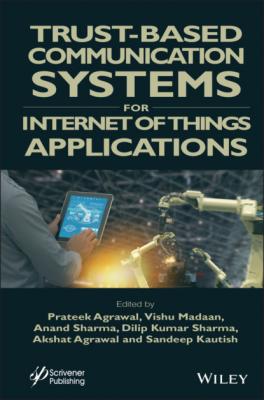Trust-Based Communication Systems for Internet of Things Applications. Группа авторов
Читать онлайн.| Название | Trust-Based Communication Systems for Internet of Things Applications |
|---|---|
| Автор произведения | Группа авторов |
| Жанр | Отраслевые издания |
| Серия | |
| Издательство | Отраслевые издания |
| Год выпуска | 0 |
| isbn | 9781119896722 |
Chapter 5 titled “CIA-CPS: Concept, Issues, and Application of IoT in Cyber Physical System” expresses the similarities and differences between IoT and CPS and various applications of IOT and CPS to show as to how both are making the life of common men easy in every walk of life.
Chapter 6 titled “Trust Calculation in IoT Nodes Without Trusted Third Party Using PUF Methodology” focuses the trust calculation in Physical Unclonable Function (PUF) based networks and finds the appropriate method in several facets of trust.
Chapter 7 titled “Comparative Analysis of Indexing Schemes Used in Cloud Computing Data Management” presents a comparative analysis of various indexing data structures used in cloud computing for data management. To evaluate the performance of the existing indexing structures, different experiments have been carried out.
Chapter 8 titled “Evolution and Insight in Industrial Internet of Things (IIoT): Importance and Impact” provides a system of IIoT, structure and IIoT layers, and IIoT applications, as well as IoT openings and difficulties. It shares the importance and progress from the Industrial IoT to the Industries 4.0 process as well as move towards the industrial Internet.
Chapter 9 titled “Evolving Trends of Artificial Intelligence and Robotics in Smart City Application: Crafting Humane Built Environment” examined the smart city concept from evolving trends of implementation with AI and Robotics in different built environment layers from micro to macro level of spaces. Additionally, a few application-based case studies and the initiatives taken by global agencies (UNESCO) were analyzed for making these implications more human-centric.
Chapter 10 titled “T-Secure IoT in Smart Home System” provides an approach to consumer satisfaction in the service of the system by the usage of a two-level bio-based Internet of Things (IoT) delivery framework for smart home systems and an android-based program for the monitoring and control of electronic devices.
Chapter 11 titled “Intelligent Micro-Mobility E-Scooter: Revolutionizing Urban Transport” presents a technical case study on how geofencing technology is used to track and trace the city’s e-scooter, in case it is stolen. The geofencing technology provides alerts to the company on a real-time basis by using IoT. The study proposes a process framework to integrate the location-tracking and monitoring system based on GPS and geofencing capabilities.
Chapter 12 titled “Automatic Booking of LPG and Leakage Detection System Using IoT” presents an IoT based cost-effective gas leakage detection system that helps the common people in their household activities.
This book primarily covers all aspects of research and development in secured communication in IoT devices starting from the fundamentals of IoT devices and ending with the decentralized and blockchain based IoT systems and IIoT applications. We feel that after reading this book, the reader will have a thorough, well rounded understanding of machine learning and data science fundamentals.
Dr. Prateek Agrawal Dr. Vishu MadaanDr. Anand Sharma Dr. Dilip SharmaMr. Akshat AgarwalDr. Sandeep Kautish
1
An Analysis of the Internet of Things (IoT) as the Defining Technology of a Generation
Deepika Gupta1*, Asmita Singh2, Anand Sharma3 and Gurpreet Singh4
1 Engineering College Bikaner, Bikaner, India
2 Poornima University, Jaipur, India
3 Mody University of Science and Technology, Lakshmangarh, India
4 G.T.B Khalsa College of Information Technology, Chhapianwali Malout, India
Abstract
Internet of Things can be best explained as a Complex Adaptive System which is emerging and in need of designing innovative ways of software and systems engineering, project management, and numerous other disciplines to develop it in the near future. IoT’s application areas are very broad to allow it to support multiple users who have different needs in turn. Three groups of users, people, society or societies, and organizations represent the app. In this paper, we have laid emphasis on the various IoT applications such as interoperability, smart cities, smart pharmacy, workplaces, home, transport, and vegetable traceability framework.
Keywords: IoT, mobile computing, smart home, wearable, etc.
1.1 Introduction
The IoT is an integrated system that looks at material with different levels of processing, hearing, and performance sharing that communicates as their integrated Internet platform as shown in Figure 1.1. The main purpose of the IoT, therefore, is to make things connected to other things and people, using any network, route, or service, anytime, anywhere.
Figure 1.1 IoT.
The IoT is increasingly being considered the next step in the evolution of the Internet. Devices such as Smartphones, cars, industrial systems, cameras, toys, buildings, household items, industrial systems, and countless others can exchange information via the Internet these days. These devices can perform fine-tuning, tracking, setting, control, real-time monitoring, and process control regardless of their size and functions [1]. The widespread proliferation of Internet-enabled devices has taken place in recent years.
1.2 Growth of IoT
The Internet certainly become a part of the life of a social animal. It is a big room for people and knowledge. The Internet first emerged as the “Computer Internet.” It is a digital network where it is possible to incorporate several services on top of it, such as the World Wide Web. It was an age of information sharing. There were several social websites that kept individuals linked all the time. This has led to the Internet being loaded with individuals rather than data. Technology, on the other hand, has been progressing day by day. A period of “MobiComp” (mobile computing) has also begun [2–4].
Mobile internet services for 3G and 4G have now resulted in quicker internet connectivity and increased video call quality. Mobile computing and wireless technology have become inexpensive and have gained more popularity. Therefore, there was a new computer-Ubiquitous computing.
Figure 1.2 Growth of Internet of Things.
Intelligent
